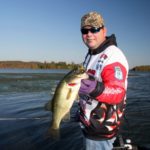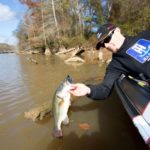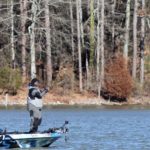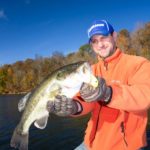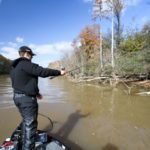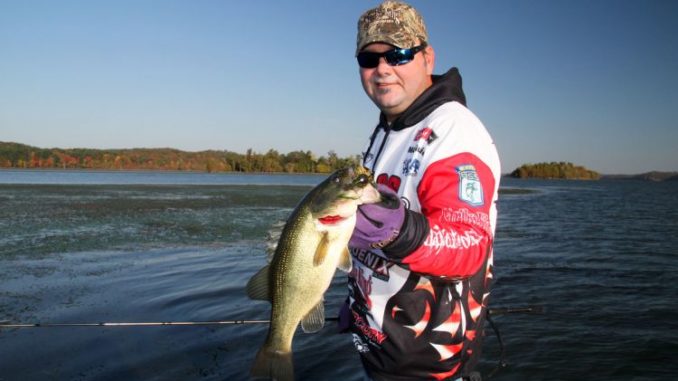
Cold days come even in Louisiana, and unprepared anglers can spend long, miserable days chasing bass. Here are how the pros fend off the bitter cold so they’ll be ready to set the hook.
Diehard anglers will brave some pretty uncomfortable conditions for that chance of bending a rod. But understanding how cold weather can affect your equipment and your performance stands essential to your winter pursuits.
Bassmaster Elite Series pro Dennis Tietje said his hometown of Roanoke doesn’t see many mornings with freezing temperatures, but the instances can be a little more frequent in the state’s upper reaches.
Even if the thermometer doesn’t dip to the low 30s, however, the chilly months still significantly impact your fishing.
“Cold weather affects everything: your boat, your electronics, the fish, the angler,” Bassmaster Elite pro Ish Monroe said. “It can take the best topwater bite you’ve ever had, and then a cold front comes in and kills it.
“It pushes the fish back; it hunkers them down. It’s like when you get cold you don’t want to do much.”
OK, so fishing stinks when the temperature plummets, but for our purposes, let’s focus on the second half of Monroe’s observation and why it’s so poignant.
Few of us really enjoy frosted misery but — because winter often finds fish ganged up — we tolerate the teeth-chattering weather in hopes of running into a few hungry bass.
The path is rarely easy, though, as a handful of limitations, impediments and challenges demand attention. Consider these when planning for the forthcoming chill.
Icy touch
Having fished Toledo Bend in the snow, Tietje knows particularly cold mornings can find water freezing in rod guides.
Considering that your presentations during such conditions are glacially slow, your line won’t have the frequent plunging action of a moving bait; therefore, water has time to sit and freeze into a trap that can limit your hooksets.
Spraying guides with WD-4, Blakemore Reel Magic or other lubricants can limit the buildup, but Tietje said he’s experiencing this vexation far less since ditching micro guides in favor of standard guides.
It stands to reason that the smaller holes are more quickly blocked by ice buildup, so keep this in mind on those bitterly cold days.
Honestly, you’re not going to deal with guide icing that often, or for an extended period of time in Louisiana — but when icing occurs, dip your rod in the water, give it a good shake and you’re back in business. The water’s still cold, but it’s warmer than the air temperature, so the rinse breaks down any ice accumulation.
Reels might also develop an icy glaze when exposed to freezing temperatures, but Monroe said if it’s so cold that his Daiwa locks up, he has no business on the water.
Nevertheless, to prevent even light icing, dab excess water off a recently used reel before placing it on the deck.
Harmful expansion
Extreme cold is a slow killer and, as Tietje pointed out, one of your biggest and potentially most-expensive hazards is one that you won’t see until it’s too late.
“Your lower unit is always your biggest concern when your boat’s out of the water,” Tietje said. “When we load our boats, we trim our motors up, but we never trim it all the way down (while it’s on the trailer).
“But when I know it’s going to be (extremely) cold, I’ll run out and trim my motor down. You’d be surprised how much water does come out. Frozen water is powerful. When water freezes, it swells and that’s what busts lower units.”
Clothing considerations
We’ve all made the mistake of hitting the pond under-dressed for the day’s conditions, but remember that there is such a thing as being overdressed.
Call it the “Goldilocks” approach: not too little, not too much, but just right.
“It usually comes down to personal comfort while it’s cold,” Tietje said. “If you’re miserable, you just don’t react or think as well.”
Doubters might challenge this by asserting that more is better, but Gonzales Elite Series pro Greg Hackney noted that overdoing it can actually leave you sweating underneath a load of clothing.
Moisture is your enemy in cold scenarios, because removing a heavy jacket exposes that sweat to the cold air, which quickly drops your surface temperature.
Rather than an all-or-nothing approach, layer with pieces you can easily shed as needed. This strategy starts with Under Armor or a comparable base layer — even old fashioned long johns will suffice — and working up with a long-sleeve shirt, maybe a fleece top and then your weather-resistant outer layer.
Trapping your body’s natural warmth is far more effective than simply repelling the cold with oversized outerwear.
“You can over-bulk, and the fatigue sets in because when you put so many clothes on,” Tietje said. “It definitely wears on you. I’ve found that if you put on cold-weather gear and a normal long-sleeve shirt, you can put on a light slicker suit.
“What you’re doing is stopping the wind, and once you do that, it’s amazing how much heat your body puts off. If you put on a heavy coat and then you put on a slicker suit, man, it just kills your shoulders — especially if you’re in a casting situation.”
To keeps his fingers functioning and to prevent numbed palms, you simply must invest in sturdy, weatherproof gloves.
Comfort matters, but detecting light bites is tough when you can’t feel those subtle ticks.
“It’s crucial to learn to cast in gloves, because in the winter time, if a fisherman’s hands get cold, that slows your reaction time,” Hackney said.
Tietje uses neoprene gloves with pull-back finger caps that allow him to maintain complete protection from cold and wind with the option of briefly exposing fingertips for fine details like tying knots.
Preferring full coverage, Hackney has taught himself to cast, reel and perform just about any fishing-related task with gloved hands.
“I actually wear gloves that are fairly thin and have textured pads on the ends of the fingers so you can operate electronics or phone iPad without taking them off,” he said.
Heavy-duty mitten-style gloves that slip over your main gloves keep the wind’s vicious bite off your fingers while you’re running.
For foot protection, some prefer lightweight, waterproof boots (i.e., duck boots work), but Monroe likes the comfort of low-cut athletic style shoes.
The key, he said, is a pair of SIMM’S neoprene wading socks — essentially, base layer for the feet.
That leaves only the head to cover up. Stocking caps, beanies, hoodies — make sure you have something to keep that body heat from escaping through your scalp.
If you need a brimmed cap to help keep the sun at bay, slip that warmer head gear over your cap. Adding a Buff or similar lightweight neck gaiter will further limit the cold’s intrusion.
Keep it toasty
Even with proper cold-weather gear, an occasional shot of concentrated warmth from a propane-fueled portable heater helps.
Tietje said a deep winter day will find him borrowing the Mr. Heater Little Buddy Heaters he keeps in his duck boat and deer blind.
“You always hate to have something burning on your deck, but it doesn’t take much to warm up,” he said.
Elite Series pro Jason Christie said it’s as much a psychological tactic as a physical comfort. Cold-weather fishing is rarely a numbers game, so you’re staying alert for long, fruitless periods.
Noting that the average year will only subject Louisiana anglers to a few icy days, Tietje said it’s still something with which every angler contends.
“All anglers need to be prepared for (extreme cold weather) because it’s going to come,” he said. “You just don’t know when it’s going to come.”
